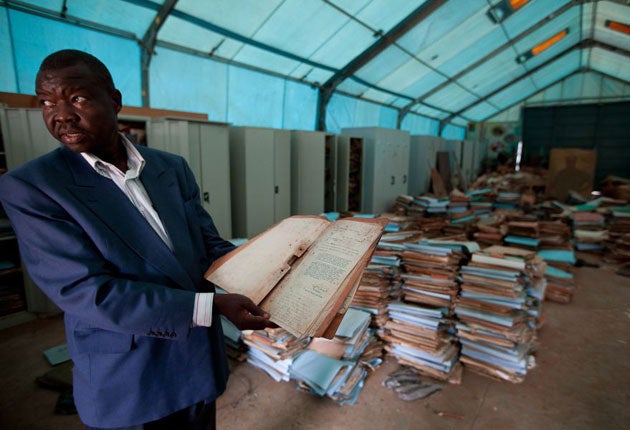How the dream of a Sudanese divorce was born
Hoard of documents reveals Britain's colonial masters were ahead of the game in the 1940s. Daniel Howden reports from Juba

The future of southern Sudan has been clear for some time: "The policy is to split the country in half and even attach the southern part to Uganda."
This is not a leaked diplomatic cable about Sudan's recent referendum on secession, for which preliminary results yesterday showed overwhelming support for divorce, but a summary of British policy towards its colonial possession as long ago as the late 1940s. It comes from a pamphlet called Basic Facts about South Sudan whose publication date has been lost to the termites that have eaten the bottom third of its pages.
The part-digested read is one of a hoard of documents, that has been slowly disintegrating in a tent in Juba, the capital of what will be confirmed as the world's newest state.
Youssef Fulgensio Onyala is the man tasked with saving what remains of southern Sudan's official papers. An archaeologist born in Juba, he trained in Beirut during the second of the two civil wars that consumed most of Sudan's half century of independence. Now returned, he is leading a small team trying to turn a century's worth of brittle documents into a permanent digital archive.
"It's a really big job," he admits. "There may be as many as one million documents and only three scanners and eight staff members."
And the conditions in which the files have been stored means it is also a race against time. The archive is housed in the kind of tent that would normally shelter southern Sudan's multitude of refugees or the humanitarian aid that feeds them. The heat makes it impossible to keep working in the tent by mid-morning. "You can only work until 11am, then we have to leave," says Mr Fulgensio-Onyala.
Inside the tent, thousands of files are piled into mounds connected by veins of brown earth left by the hungry termites. A portrait of Sudan's former president, Jaafar Numeiri, looms out of the half-light. Among the fascinating colonial bric-a-brac is a poster featuring extravagant jungle scenes under the words: "Tourism is Yourism" and boasting that the southern region is a "paradise of wildlife conservation".
The piles are arranged in geographical order and a quick survey offers tantalising glimpses of a largely forgotten past. Sudan's colonial masters had a greater sympathy for the Arab-dominated north and dispatched the scions of England's public schools to Khartoum. In contrast, the south was seen as "African" and in need of protection from development and administered as a condominium, carved up among a few colonial officers and missionaries.
Among them was AJ Arkell, who in 1947 received a request from Khartoum to help with a dictionary of place names. Anticipating that many of his colleagues would have no idea where they were, the letter implores: "Send in all the names you know even if it is not more than one."
A concerned Roger Brock wrote in 1940 from Bahr el Ghazal – close to what is now the border with southern Darfur – of a row between two chiefs. Mr Brock took sides and sent "a policeman to burn the houses of those who had insulted the sons" of his favoured chief.
Littered among these fragments are the remains of artefacts intended for museums that were never built. A rusting Nuer tribal shield from Malakal leans against a filing cabinet bursting with crumbling books.
One stack of files contains some of the vast number of personality profiles the British officials compiled on the locals they had made chiefs in order to prop up their system of "indirect rule". One sheet proclaims a Chief Apam as "well above the average in intelligence and personality".
The survival of the archive is not just about South Sudan's past but also its future, says John Ryle, director of the Rift Valley Institute, which is assisting in the project. "It's a big country and there's not much to build it on," he says. "This a fantastic resource for creating a proper history of what's made the country what it is."
The super-hot tent, erected with funds from USAID, is also an improvement on what Mr Fulgensio Onyala found when the project began three years ago.
After the 22-year civil war the surviving papers in Juba were stuffed into the basements of long-deserted buildings. Some were in rooms that had been locked for two decades and he remembers having to "smash doors and windows" to recover what was inside.
Among the documents were hundreds that had been collected from other regions by British historian Douglas Johnson. He remembers overseeing the transfer of 5,000 files from former colonial offices during the 1970s. But in the absence of a permanent home in they were stored in beer cartons – Tusker Export being just the right size.
Mr Johnson returned to Juba in 2006 to help train the new team and lobby again for the archive to be given its own building. The value of the records goes beyond assisting historians, he says, and the archive may hold the key to South Sudan's contentious borders with the north. Equally, it may be invaluable to the new government as it tries to unravel the origins of the complex traditional authorities, some of which were invented on the spot by colonial officers.
"What it needs is a building in which to store the documents safely," he says. "As the South faces a new future, let it also pay attention to, and preserve, its past."
Subscribe to Independent Premium to bookmark this article
Want to bookmark your favourite articles and stories to read or reference later? Start your Independent Premium subscription today.

Join our commenting forum
Join thought-provoking conversations, follow other Independent readers and see their replies